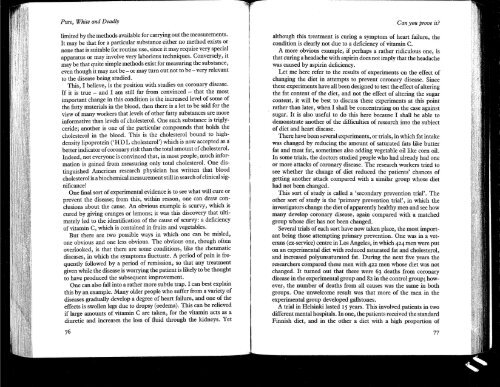John_Yudkin_-_Pure_White_and_Deadly_revised_1986_OCR
John_Yudkin_-_Pure_White_and_Deadly_revised_1986_OCR
John_Yudkin_-_Pure_White_and_Deadly_revised_1986_OCR
Create successful ePaper yourself
Turn your PDF publications into a flip-book with our unique Google optimized e-Paper software.
<strong>Pure</strong>, <strong>White</strong> <strong>and</strong> <strong>Deadly</strong><br />
limited by the methods available for carrying out the measurements.<br />
It may be that for a particular substance either no method exists or<br />
none that is suitable for routine use, since it may require very special<br />
apparatus or may involve very laborious techniques. Conversely, it<br />
may be that quite simple methods exist for measuring the substance,<br />
even though it may not be - or may turn out not to be - very relevant<br />
to the disease being studied.<br />
This, I believe, is the position with studies on coronary disease.<br />
If it is true - <strong>and</strong> I am still far from convinced - that the most<br />
important change in this condition is the increased level of some of<br />
the fatty materials in the blood, then there is a lot to be said for the<br />
view of many workers that levels of other fatty substances are more<br />
informative than levels of cholesterol. One such substance is triglyceride'<br />
another is one of the particular compounds that holds the<br />
choles~erol in the blood. This is the cholesterol bound to highdensity<br />
lipoprotein ('HDL cholesterol') which is now accepted as a<br />
better indicator of coronary risk than the total amount of cholesterol.<br />
Indeed, not everyone is convinced that, in most people, much inf~rmation<br />
is gained from measuring only total cholesterol. One dlstinguished<br />
American research physician. h~s written ~a~ blo?d<br />
cholesterol is a biochemical measurement sull ill search of clinIcal SIgnificance!<br />
One final sort of experimental evidence is to see what will cure or<br />
prevent the disease; from this, within reason, ?ne can draw. co~clusions<br />
about the cause. An obvious example IS scurvy, which IS<br />
cured by giving oranges or lemons; it was this discovery that. ultimately<br />
led to the identification of the cause of scurvy: a deficIency<br />
of vitamin C, which is contained in fruits <strong>and</strong> vegetables. .<br />
But there are two possible ways in which one can be mlsled,<br />
one obvious <strong>and</strong> one less obvious. The obvious one, though often<br />
overlooked, is that there are some conditions, like the rheumatic<br />
diseases, in which the symptoms fluctuate. A period of pain is frequently<br />
followed by a period of remission, so that any treatment<br />
given while the disease is worrying the patient is likely to be thought<br />
to have produced the subsequent improvement. .<br />
One can also fall into a rather more subtle trap. I can best explam<br />
this by an example. Many older people who suffer from a variety of<br />
diseases gradually develop a degree of heart failure, <strong>and</strong> one of the<br />
effects is swollen legs due to dropsy (oedema). This can be relieved<br />
if large amounts of vitamin C are taken, for the vitamin acts as a<br />
diuretic <strong>and</strong> increases the loss of fluid through the kidneys. Yet<br />
Can yo1f, prove it?<br />
although this treatment is curing a symptom of heart failure, the<br />
condition is clearly not due to a deficiency of vitamin C.<br />
A more obvious example, if perhaps a rather ridiculous one, is<br />
that curing a headache with aspirin does not imply that the headache<br />
was caused by aspirin deficiency.<br />
Let me here refer to the results of experiments on the effect of<br />
changing the diet in attempts to prevent coronary disease. Since<br />
these experiments have all been designed to test the effect of altering<br />
the fat content of the diet, <strong>and</strong> not the effect of altering the sugar<br />
content, it will be best to discuss these experiments at this point<br />
rather than later, when I shall be concentrating on the case against<br />
sugar. It is also useful to do this here because I shall be able to<br />
demonstrate another of the difficulties of research into the subject<br />
of diet <strong>and</strong> heart disease.<br />
There have been several experiments, or trials, in which fat intake<br />
was changed by reducing the amount of saturated fats like butter<br />
fat <strong>and</strong> meat fat, sometimes also adding vegetable oil like corn oil.<br />
In some trials, the doctors studied people who had already had one<br />
or more attacks of coronary disease. The research workers tried to<br />
see whether the change of diet reduced the patients' chances of<br />
getting another attack compared with a similar group whose diet<br />
had not been changed.<br />
This sort of study is called a 'secondary prevention trial'. The<br />
other sort of study is the 'primary prevention trial', in which the<br />
investigators change the diet of apparently healthy men <strong>and</strong> see how<br />
many develop coronary disease, again compared with a matched<br />
group whose diet has not been changed.<br />
Several trials of each sort have now taken place, the most important<br />
being those attempting primary prevention. One was in a veterails<br />
(ex-service) centre in Los Angeles, in which 424 men were put<br />
on an experimental diet with reduced saturated fat <strong>and</strong> cholesterol,<br />
<strong>and</strong> increased polyunsaturated fat. During the next five years the<br />
researchers compared these men with 422 men whose diet was not<br />
changed. It turned out that there were 63 deaths from coronary<br />
disease in the experimental group <strong>and</strong> 82 in the control group; however,<br />
the number of deaths from all causes was the same in both<br />
groups. One unwelcome result was that more of the men in the<br />
experimental group developed gallstones.<br />
A trial in Helsinki lasted 15 years. This involved patients in two<br />
different mental hospitals. In one, the patients received the st<strong>and</strong>ard<br />
Finnish diet, <strong>and</strong> in the other a diet with a high proportion of



